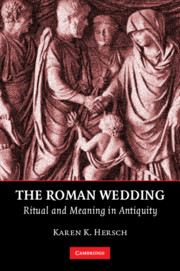2 - At the House of the Bride
Published online by Cambridge University Press: 05 June 2012
Summary
THE IDEAL BRIDE
The purpose of a Roman marriage was to ensure that children would be legitimate, thus, the purpose of the wedding was to ensure that the sexuality and reproduction of the bride, who was expected to be a virgin if marrying for the first time, were transferred safely into the confines of a legal marriage. In descriptions of the wedding in epithalamia, virginity and desire are for the most part antithetical. Catullus described the bride Junia as cupida, or “desirous,” for her new husband, but this desire may not be sexual: the poet warned the virgin bride that she must take care to please her man or he will seek greener pastures. In later epithalamia, Venus and Cupid endeavor to make the bride beautiful and beloved for the pleasure of the groom alone; rarely is there an indication of the importance of the bride's pleasure. Roman writers asserted that if plans have gone according to schedule, the bride will be a virgin and the wedding night will be a horror. One of Nero's despicable acts was to make a joke of the bride's terror or pain as she lost her virginity. Was the image of a shy, reluctant, or grieving bride a mere artistic conceit? Was the core of this lament adapted from the Greek wedding? The frequency with which the grieving bride appears in Roman literature allows us to argue that the bride's lamentation itself, whether false or true, was a normal part of the ceremony.
- Type
- Chapter
- Information
- The Roman WeddingRitual and Meaning in Antiquity, pp. 61 - 134Publisher: Cambridge University PressPrint publication year: 2010

